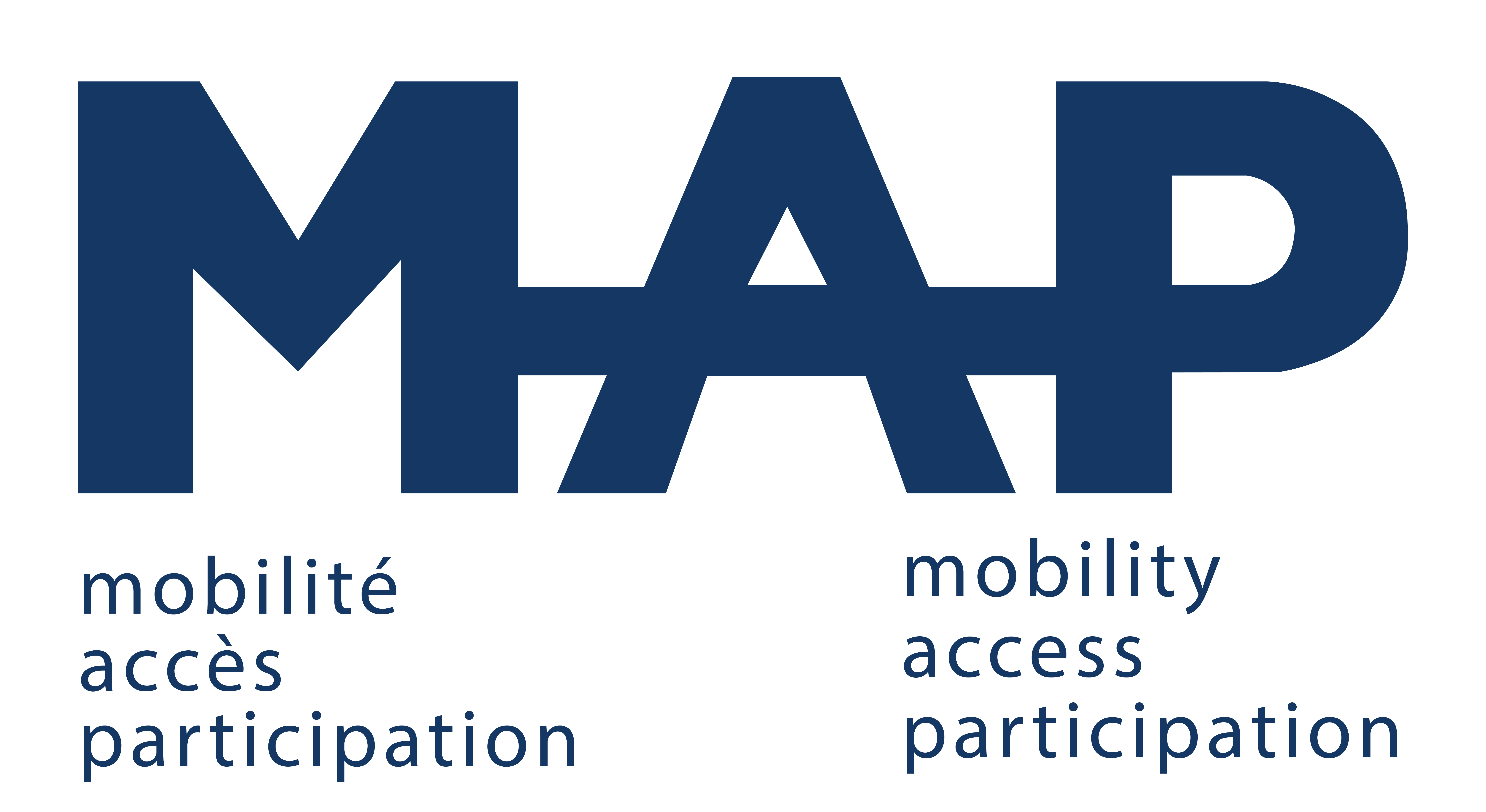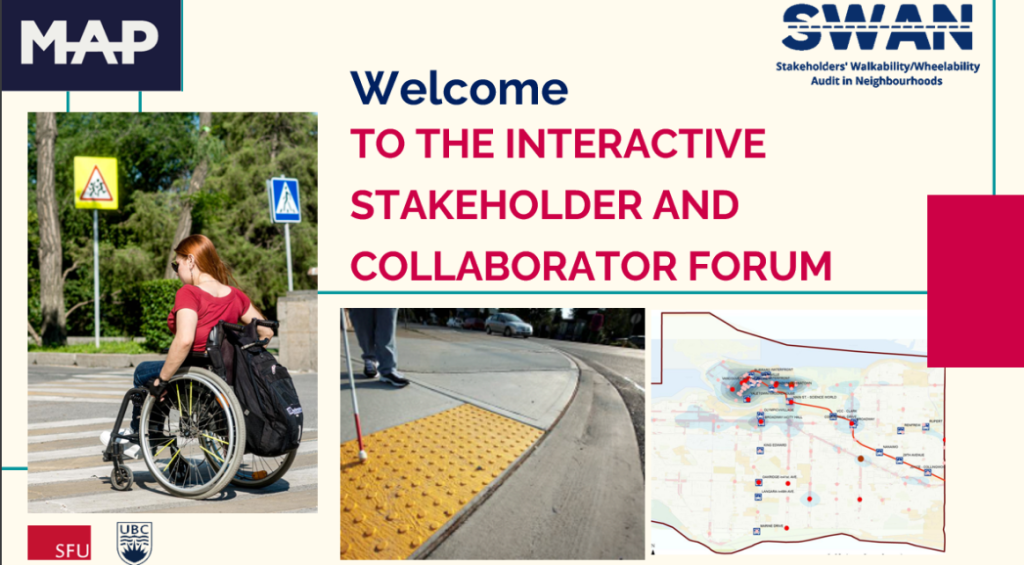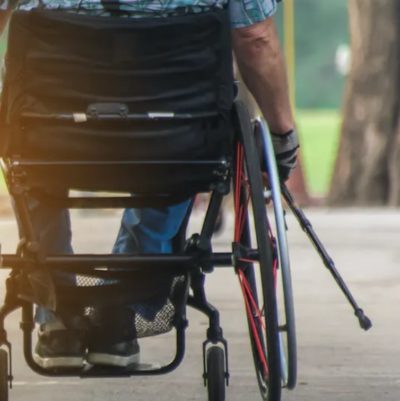June 13th, 2022
Aislynn Sharrock, Farinaz Riktehgaran, and Diana Juanita Mora
The aim of the Stakeholder’s Walkability/Wheelability Audit in Neighbourhoods (SWAN) project, a sub-project of the Mobility Access Participation (MAP) Project, is to connect with community members in order to assess the accessibility of streets through the lens of people living with different disabilities (e.g., sensory, cognitive). Using a community-engaged approach, defined as “a set of practices, values and objectives that emphasize active participation of the individuals and communities directly affected by research activities,” our team works to connect, collaborate, and build trust with members of the community through our various research activities. In line with this approach, our team came together to plan and host an interactive hybrid forum to co-identify areas for data collection with our community partners and stakeholders, as well as plan for their engagement in the next phases of our project. Through this, we provided the opportunity for the community stakeholders to be more involved in the design and structure of our research project. Applying a community-engaged approach allows us to raise the voice of people with disabilities and build more accessible and responsive urban spaces.
To make this event a success, planning and preparation started several months in advance! Bringing this event together involved the efforts of all team members and required input from several stakeholders such as our municipal partners. For example, our preparation efforts included a review of relevant accessibility and urban municipal policies, selecting potential areas for data collection using open-source data (e.g., pedestrian crashes, land use, transportation hubs) and producing and overlaying GIS data layers, conducting site visits to all our potential data collection sites, and lastly reviewing our plans with our municipal partners to incorporate their expert feedback.

The event occurred on March 4th, 2022 which kicked off with a presentation by the former municipal partner from the City of Burnaby, Rebecca Mahaffey, and a community partner from Better Environmentally Sound Transportation, Janette McIntosh, who spoke to the past success brought by using the SWAN tool in the community. This allowed us to highlight the improvement seen in the community’s urban environment brought by the application of the SWAN tool. It also gave our attendees an overview of the partnership with the Gerontology Department. With a total of 40 attendees, our team members facilitated six hybrid breakout rooms/forums which focused on prioritizing areas for data collection by exploring the knowledge, opinions, and experiences of all attendees regarding the pre-identified intersections. This portion of the event adopted an interactive component which used visuals including recent photos of the intersections and Google Jamboards. The sessions revealed rich information about the challenges that people encounter in these areas and helped our team narrow down what intersections were feasible areas for data collection. We wrapped things up by asking about the barriers our municipal partners might face when trying to improve the accessibility of these areas, and how our attendees would like to be involved in the SWAN project moving forward.

The results of our discussions in the breakout rooms showed that intersections prioritized throughout the Lower Mainland shared many concerns. For example, our stakeholders spoke of the insufficient crossing time present for pedestrians of all ages and abilities to cross safely at major crosswalks. Moreover, of the ambiguity between road space for vehicles, cyclists, and pedestrians, with a lack of distinct features to separate the shared road space. Additionally, a lack of necessary directional information needed for pedestrians with sensory disabilities. Lastly, the influences of a high density of traffic, pedestrian populations, and construction in creating high levels of noise, increase the difficulty of hearing auditory cues. These points were just a few that were highlighted by our stakeholders as having the most influence on the experience of people living with disabilities in accessing their communities.
Subsequently, several challenges that come with improving the accessibility of these areas were discussed. Some of the main challenges include balancing the needs of vehicle users and of pedestrians. To make considerable accessibility changes to our intersections that promote walkability and wheelabity, there must be considerations for impacts on traffic flow, as well as driver mentality education, such as slowing down, giving the right-of-way, and being patient with pedestrians. Additionally, trying to find creative ways to work with developers and private property owners to have a consistent approach to making sidewalks and crossings safer and more accessible. Other considerations such as understanding how these changes may impact neighbouring businesses, working within annual City budgets, and logistical barriers to implementing changes all prove to be challenges when it comes to improving the accessibility of these areas.

Following the event, our team compiled what was learnt and sent out a summary of the event to all the attendees, including a short survey for feedback and future involvement in the project. The “Stakeholder’s Engagement” event allowed us to strengthen connections with our partners as well as co-identify areas for data collection. Through this short survey, we have been able to get a closer look at what our attendees would like to be involved in the future. The responses showed that many of our stakeholders would like to get involved in ‘implementing interventions projects and programs’, and ‘participating in municipality focused groups’. With our continued strive to keep the community engaged, these responses to our event will allow us to better direct future conversations with our partners to build the necessary relationships. Following this event, our team came together and finalized the tool and training sessions for data collection. We have started the process of participant recruitment and data collection since mid-May. The SWAN research team intends to host more knowledge mobilization events in the future to raise awareness, disseminate the research findings, and actively involve the community in research on the accessibility of urban public spaces for people living with disabilities.



